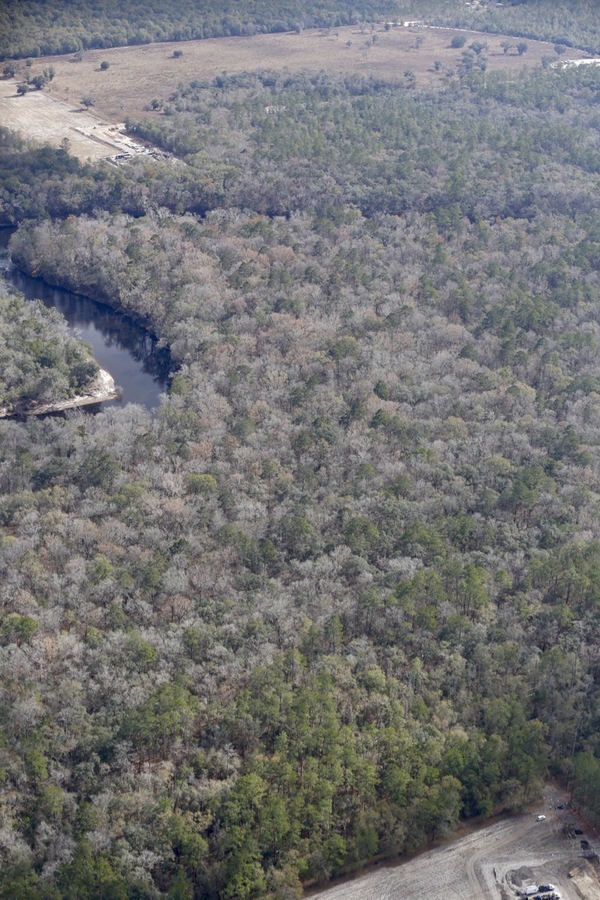For once a news story gives the last word to local water protectors, and it plays up our land and our water.
 Richard Luscombe, The Guardian, 24 January 2017,
Why a protest camp in Florida is being called the next Standing Rock:
At first glance the quiet town of Live Oak seems an unlikely venue for a stand against Big Energy. But in recent weeks it’s become a centre of opposition,
Richard Luscombe, The Guardian, 24 January 2017,
Why a protest camp in Florida is being called the next Standing Rock:
At first glance the quiet town of Live Oak seems an unlikely venue for a stand against Big Energy. But in recent weeks it’s become a centre of opposition,
A north Florida river that attracted the state’s first tourists a century before Walt Disney’s famous cartoon mouse is emerging at the centre of a fight against a contentious 515-mile natural gas pipeline that many are calling America’s next Standing Rock.
One section of the so-called Sabal Trail pipeline is being laid beneath the crystal waters of the Suwannee river, whose pure mineral springs were once fabled to cure anything from marital strife to gout.
The story quotes Debra Johnson of Sacred Water Camp, Bobby C. Billie, Shannon Larsen, and others, and mentions the arrests and other actions. Please read it.
Since this is the WWALS blog:
Opponents say the building of the pipeline is harming not only the natural beauty of places such as the Suwannee, but irreversibly damaging sensitive environmental and culturally important areas in all three states, and threatening the supply of clean drinking water for millions.
“This is our land and our water, not theirs,” says John Quarterman, president of the WWALS Watershed Coalition that advocates for the conservation of five rivers in Georgia and Florida, including the Suwannee. “We can’t just sit here and let them come through here. We have to do something about it.”
In these parts of northern Florida, as in much of the rest of the state, the karst bedrock being drilled for the pipeline is a fragile and porous limestone.
Campaigners say that drilling has already resulted in sinkholes forming at several sites, and claim to have evidence of inadequate construction practices, including photographs from the air appearing to show the leaking of drilling mud into Georgia’s Withlacoochee river from a frac-out.
As usual, Sabal Trail only interacted with the reporter via email statements from Andrea Grover, Spectra Energy Director of Stakeholder Outreach, with her usual misinformation:
The pipeline, she said, was needed to upgrade Florida’s “fully or near-fully subscribed” natural gas transmission infrastructure…”
See below for why that claim is irrelevant.
Ms. Grover continued:
…and its route and construction techniques were determined, after a lengthy consultation period, to “avoid, minimize or mitigate impacts”.
“There were communications, comment periods, face-to-face and public meetings with landowners, community members and public officials,” she said, adding that the Federal Energy Regulatory Commission (FERC) and “other pertinent federal and state environmental permitting agencies” conducted regular inspections.
Including WWALS vs. Sabal Trail & FDEP, in which Sabal Trail and FDEP assured us there would be no risk to the Suwannee River because the pipeline was drilling upland to upland, yet in the same karst limestone geology Sabal Trail already blew a frac-out of drilling mud up into the Withlacoochee River in Georgia and caused a sinkhole. What they said would never happen is happening.
Grover insisted construction “closely adhered to all applicable environmental standards,” was required to restore affected land, and that Sabal Trail “is dedicated to the safe, reliable operation of facilities and the protection of the public, the environment and our employees”.
The drilling mud from the Withlacoochee frac-out, she said, “is primarily a mixture of naturally occurring bentonite clay and water. There was never any danger to human health or safety, and no harm to the environment.”
I never call Ms. Grover a liar, because she’s so good at never saying anything that’s exactly technically incorrect. But this time I’ll come out and say it: “never any danger” and “no harm to the environment” is simply a lie.
When I had a Georgia Department of Environmental employee and two Sabal Trail foremen down at the Withlacoochee River at the frac-out site, I asked them, “where else did the drilling mud go underground?” All three of them just shook their heads, because there was nothing else they could do. Nobody knows. Nobody will know, unti it comes up in somebody’s well, or causes a sinkhole, or river water leaks into a water treatment plant and interacts with the treatment chemicals, producing toxic byproducts. Sabal Trail and the permitting agencies can’t claim not to know this information about the geology, or sinkholes, or river water and treatment chemicals. WWALS sent it to them more than once. Plus bentonite itself depletes oxygen and thus affects fish in the river.
The story concludes:
The claims, however, cut little ice with Quarterman, who believes drilling for the pipeline is producing more sinkholes, which could lead to pipeline failure.
“It’s not just one or two places, they’re causing more of them. We can see this from the air,” he said.
The bottom line, he says, is that the Sabal Trail pipeline is a risky venture that is neither wanted nor needed, pointing out that FPL’s own 10-year plan published last year states that Florida does not need any new electricity resource until 2024.
-jsq, John S. Quarterman, Suwannee RIVERKEEPER®
You can join this fun and work by becoming a WWALS member today!
Short Link:
